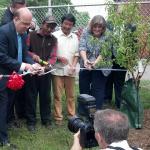A monthly e-newsletter from UMass Extension for landscapers, arborists, and other Green Industry professionals, including monthly tips for home gardeners.
To read individual sections of the message, click on the section headings below to expand the content:
Hot Topics
Diseases of Landscape Conifers
Conifers in both landscapes and natural areas face a number of stresses and disease pathogens. View the recording of this recent Urban Forestry Today webinar on these topics at http://www.urbanforestrytoday.org/webcast-archives.html.
- Diseases of Landscape Conifers - Dr. Nicholas Brazee, UMass Extension Plant Diagnostic Lab
- Pathogens of Eastern White Pine - Dr. Cameron McIntire, USDA Forest Service
Peak Tick and Mosquito Season in Massachusetts is Coming… Are you prepared?
This 2-day virtual webinar series will call upon topic experts to provide information about the seasonality, biology, and the diseases these organisms vector, as well as how to manage these pests and steps you can take to protect yourself.
Recommended for landscape and turf professionals, arborists, tree wardens, urban foresters, foresters, land managers, and any professionals or individuals working outside as well as public health officials and property owners in Massachusetts.
Tuesday, June 8: TICK TOPICS, 10:00 am – 12:10 pm
- Tick Management in the Landscape
- The Outreach Hiker’s Guide to Tick-ology: Personal tick bite prevention and more!
Tuesday, June 15: MOSQUITO TOPICS, 10:00 am – 12:10 pm
- Mosquitoes in Massachusetts, Arboviruses and Protecting Yourself
- Dealing With the Asian Tiger Mosquito: Incorporating an Invasive Species into an Existing Mosquito Control Program
For more details, the full schedule, and registration info, go to: https://ag.umass.edu/landscape/events/tick-mosquito-education-days.
Featured Plant
Chionanthus virginicus, White Fringetree
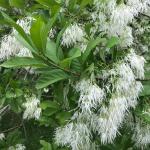 White fringetree is a slow growing, small deciduous tree with an oval or spreading rounded habit forming a dome shape. It grows 12-20 feet tall and wide, but can grow up to 30 feet tall in natural habitats such as rich moist woods, moist hillsides and moist stream banks. White fringetree is typically multi-stemmed, but can be pruned to a single stem. The bark is pale gray or light gray-brown in color. Leaves are opposite, 3-4 inches long and vary from medium to dark green with various degrees of glossiness. In fall, leaves turn a yellowish brown to golden yellow; fall color is usually not significant. Masses of showy, slightly fragrant, lacy, white flowers are borne in 6- to 8–inch-long panicles in May and June. Fringetree is dioecious, with male and female flowers on separate plants.
White fringetree is a slow growing, small deciduous tree with an oval or spreading rounded habit forming a dome shape. It grows 12-20 feet tall and wide, but can grow up to 30 feet tall in natural habitats such as rich moist woods, moist hillsides and moist stream banks. White fringetree is typically multi-stemmed, but can be pruned to a single stem. The bark is pale gray or light gray-brown in color. Leaves are opposite, 3-4 inches long and vary from medium to dark green with various degrees of glossiness. In fall, leaves turn a yellowish brown to golden yellow; fall color is usually not significant. Masses of showy, slightly fragrant, lacy, white flowers are borne in 6- to 8–inch-long panicles in May and June. Fringetree is dioecious, with male and female flowers on separate plants.
The flowers hang in showy, branched clusters; male flowers are showier than female flowers and open before or with the first leaves. Fertilized female flowers give way to clusters of olive-like fruits which ripen to a dark, bluish black in late summer. The fruits are a good food source for birds. Both male and female plants must be in the same area for fruit to be produced. Fringetrees are usually not available labeled as male or female, so it is impossible to know which one you are getting unless they are purchased in bloom or with fruit present. Fortunately, both male and female trees are beautiful.
White fringetree is native to southern New Jersey, south to Florida and west to Texas. However, it is very cold hardy and grows well in USDA zones 4 to 9. White fringetree performs best in well drained, deep, moist, fertile soils in full sun to part shade. It does not tolerate prolonged dry conditions.
There are two species of fringetree available, the native white fringetree (Chionanthus virginicus) and the Chinese fringetree (Chionanthus retusus). White fringetree, is native to the eastern and southeastern United States and Chinese fringetree is native to eastern Asia. Chinese fringetree blooms at about the same time as the white fringetree, but its flowers are held in smaller clusters. The flower clusters are also denser and held at the ends of the branches.
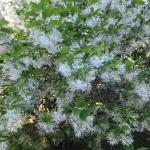 Uses - Fringetree can be used as a specimen plant in the landscape or planted in small groups in mixed shrub borders, screens or in a woodland garden. It can be a beautiful accent for foundation plantings, especially against red brick or dark colored homes. Fringetrees are also excellent anywhere a small tree is needed, such as near a patio, in small yards, or under power lines.
Uses - Fringetree can be used as a specimen plant in the landscape or planted in small groups in mixed shrub borders, screens or in a woodland garden. It can be a beautiful accent for foundation plantings, especially against red brick or dark colored homes. Fringetrees are also excellent anywhere a small tree is needed, such as near a patio, in small yards, or under power lines.
Potential Problems - Fringetrees have no commonly seen serious disease and insect pest problems but have some susceptibility to scale and borers, particularly when grown in dry locations. However, recent research has shown that the invasive emerald ash borer (Agrilus planipennis; EAB) is capable of completing its life cycle in white fringetree. While ash (Fraxinus spp.) hosts remain the favored food for this insect, in areas where EAB is present in the Fraxinus population, it is possible for white fringetree to be attacked as well. Phytophthora root rot can occur on plants in soils with poor drainage.
Geoffrey Njue, UMass Extension Sustainable Landscapes Specialist
Glyphosate vs. Alternatives in the Landscape: Hazards to Human Health and the Environment
People often ask about alternatives to glyphosate because of perceived concerns about health and environmental effects. Joe Neal and Andy Senesac, Extension Weed Specialists with NC State and Cornell, respectively, put together an excellent piece on alternatives to glyphosate for weed control in landscapes, available at https://content.ces.ncsu.edu/are-there-alternatives-to-glyphosate-for-weed-control-in-landscapes. They looked primarily at effectiveness, but let’s compare the labels of products they mentioned with respect to hazards to people and the environment, because that’s why people are looking for alternatives in the first place.
In the table below, alternative active ingredients are listed on the left. Across the top are the types of human health and environmental hazard statements you can find on each label as well as the product’s relative toxicity (indicated by the signal word) and the personal protective equipment (PPE) needed. A plus sign in a given column means the label for the alternative product indicates it poses a greater hazard than Roundup ProTM, and a minus sign indicates a lower hazard. A blank just means the labels indicate no difference between the alternative product and Roundup ProTM.
Glyphosate vs Alternatives in the Landscape: Hazards to Human Health and the Environment
Key: + Higher hazard/restriction - Lower hazard/restriction
|
ACTIVE INGREDIENT |
LABEL PRECAUTIONARY STATEMENTS | ||||||||
|---|---|---|---|---|---|---|---|---|---|
| Relative Toxicity |
Eye Hazard |
Dermal Hazard |
Oral Hazard |
Inhalation Hazard |
PPE |
Domestic Animals |
Non-target Animals |
Groundwater/ Surfacewater Advisory |
|
| Ammonium salts of fatty acids |
+ |
+ |
+ |
+ |
- |
+ |
|||
| Bentazon |
+ |
+ |
+ |
- |
+ |
||||
| Caprylic/capric acid |
+ |
+ |
+ |
- |
+ |
||||
| Clethodim |
+ |
+ |
+ |
- |
+ |
||||
| Clopyralid |
+ |
+ |
- |
+ |
|||||
| d-Limonene |
+ |
+ |
- |
||||||
| Fenoxaprop-ethyl |
+ |
+ |
- |
+ |
|||||
| Fluazifop-p |
+ |
+ |
+ |
+ |
- |
+ |
+ |
||
| Glufosinate |
+ |
+ |
+ |
+ |
+ |
+ |
- |
+ |
|
| Halosulfuron |
+ |
- |
+ |
||||||
| Pelargonic acid |
+ |
+ |
+ |
+ |
+ |
- |
|||
| Sethoxydim |
+ |
+ |
+ |
+ |
- |
||||
| Sulfentrazone |
+ |
+ |
+ |
+ |
- |
+ |
+ |
||
| Triclopyr |
+ |
- |
+ |
+ |
|||||
| Vinegar/acetic acid |
+ |
+ |
+ |
+ |
+ |
- |
+ |
||
The only minus signs are in the domestic animal column because Roundup ProTM, though relatively nontoxic to domestic animals, may cause temporary nausea or diarrhea in animals that consume the product itself or eat large amounts of freshly treated vegetation. Notice, however, there are multiple plus signs for every alternative product, even vinegar. You can see that there’s a lot to think about when considering alternatives to glyphosate.
All of these products are sound management options and, when used according to label directions, none will pose an unreasonable risk to people or the environment because that’s EPA’s standard for allowing their use. But things don’t always go according to plan; for example, a sprayer hose might burst or you might spill some product. Even nonchemical controls pose hazards; string trimmers, for example, require the use of hearing and eye protection, can fling rocks up to 50 feet, and expose the user to engine exhaust, which is listed as “possibly carcinogenic.” So when you look for “safer” alternatives, remember that every pest management tool poses hazards of its own and therefore presents some level of risk; it is up to you to take the necessary steps to minimize risks to yourself, others, and the environment.
Dan Wixted, Cornell University Cooperative Extension Support Specialist
Trouble Maker of the Month
Insect Potpourri
It’s very difficult to pick just one “trouble maker of the month” when it comes to insect pests of trees and shrubs. Those featured here are making up the majority of questions coming in right now from professionals and property owners in Massachusetts.
Snowball Aphid: Neoceruraphis viburnicola is capable of causing severe leaf curling damage to Viburnum opulus, V. opulus ‘Roseum’ (formerly ‘Sterilis’), V. acerifolium and V. prunifolium. Certain other species of viburnum, on the other hand, appear to be resistant to this insect (such as Viburnum plicatum f. tomentosum). The snowball aphid causes twisting of foliage early in the spring by feeding on plant fluids with piercing-sucking mouthparts. Presently in Massachusetts, the damage from these insects is very noticeable and anecdotally seems more pronounced this year in some locations. Like many aphids, the snowball aphid has a complex lifecycle, part of which is unfortunately still unknown to science. While viburnum are primarily impacted, snowball aphids also have a secondary host plant whose identity is as of yet unknown.
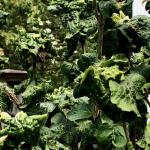
 Viburnum is the host on which this insect overwinters, after the aphids lay their eggs on the twigs and buds in the fall. The egg stage overwinters, and hatches at the same time that buds begin to open in the spring. The young, developing aphids will feed at the buds in the spring. As the aphids mature, they reach approximately 2.5 mm. (1/10 inch) in size and may be bluish-white in color, their bodies appearing as if they’ve been dusted in powdered sugar. The mature, asexual stem mothers of this species produce a large number of offspring without mating. Approximately two months following egg hatch, the progeny of the stem mothers leave the viburnum, but it is unclear where they go. By September, they return as a migrant form of aphid (to the viburnum), and give birth to the sexual forms of the species that produce the overwintering eggs. While snowball aphid is not found on viburnum year round*, the leaf-curl damage from this insect can last beyond the time when the aphids are physically present.
Viburnum is the host on which this insect overwinters, after the aphids lay their eggs on the twigs and buds in the fall. The egg stage overwinters, and hatches at the same time that buds begin to open in the spring. The young, developing aphids will feed at the buds in the spring. As the aphids mature, they reach approximately 2.5 mm. (1/10 inch) in size and may be bluish-white in color, their bodies appearing as if they’ve been dusted in powdered sugar. The mature, asexual stem mothers of this species produce a large number of offspring without mating. Approximately two months following egg hatch, the progeny of the stem mothers leave the viburnum, but it is unclear where they go. By September, they return as a migrant form of aphid (to the viburnum), and give birth to the sexual forms of the species that produce the overwintering eggs. While snowball aphid is not found on viburnum year round*, the leaf-curl damage from this insect can last beyond the time when the aphids are physically present.
Management: The damage seen on viburnum at this time from the native snowball aphid is currently not reversible with chemical management this season. Some professionals and homeowners may choose to prune severely distorted plants if the level of aesthetic damage is currently unacceptable and the damage is localized on specific branches. Remember that any remaining aphids found in the curled leaves will be protected from contact insecticide applications. Viburnums that are in bloom (or soon will be) should not be treated with systemic insecticides for the protection of pollinators. For next season: If you have viburnum species (such as those listed above) that are highly susceptible to this insect and frequently attacked, you may consider replanting with a resistant species if that makes sense for the landscape. Dormant oil applications may also be made on susceptible plants just prior to budbreak when temperatures and weather conditions allow. Target the buds and twigs for overwintering eggs with these applications.
*Note that there is another species of aphid (Aphis viburniphila) which is noted in the literature to have a year-round association with Viburnum spp.; yet this insect does not cause leaf distortion.
Hemlock Woolly Adelgid: Adelges tsugae (HWA) is a non-native insect that has been found in much of Massachusetts since 1989. The first record of HWA in the US was from Richmond, Virginia in 1951. This tiny, aphid-like insect uses a long piercing-sucking type mouthpart (stylet) to feed at the base of eastern (Tsuga canadensis) and Carolina hemlock (T. caroliniana) needles.
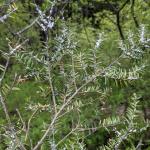
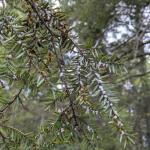 These insects feed on the nutrients found in the xylem of their hosts. Feeding from HWA causes discoloration, desiccation, needle loss, and dieback of branches in susceptible hosts. As the infestation progresses, crown vigor declines, leading to branch dieback and tree death. Research has shown that HWA can be fatal to hemlocks of all ages in 4-15 years, depending upon moisture availability and other factors influencing tree stress at the site. However, in the Northeastern US, historically, some hemlock trees have been able to persist at the higher end of that range or more, possibly due to winter mortality of the adelgid. In their native Japan, hemlock woolly adelgids alternate between southern Japanese hemlock (Tsuga sieboldii) and tiger-tail spruce (Picea torano). On the alternate spruce host, there is a sexual generation that creates galls. Without the presence of this specific spruce host, HWA can have continuous asexual generations on hemlock. This is what happens in eastern North America - hemlock woolly adelgids are all females that reproduce parthenogenetically.
These insects feed on the nutrients found in the xylem of their hosts. Feeding from HWA causes discoloration, desiccation, needle loss, and dieback of branches in susceptible hosts. As the infestation progresses, crown vigor declines, leading to branch dieback and tree death. Research has shown that HWA can be fatal to hemlocks of all ages in 4-15 years, depending upon moisture availability and other factors influencing tree stress at the site. However, in the Northeastern US, historically, some hemlock trees have been able to persist at the higher end of that range or more, possibly due to winter mortality of the adelgid. In their native Japan, hemlock woolly adelgids alternate between southern Japanese hemlock (Tsuga sieboldii) and tiger-tail spruce (Picea torano). On the alternate spruce host, there is a sexual generation that creates galls. Without the presence of this specific spruce host, HWA can have continuous asexual generations on hemlock. This is what happens in eastern North America - hemlock woolly adelgids are all females that reproduce parthenogenetically.
The overwintering hemlock woolly adelgid generation (sistens) is present through mid-spring and produces the spring generation (progrediens) which is present from early spring through mid-summer. HWA, unlike many other insects, does most of its feeding over the winter. Eggs may be found in woolly masses at the base of hemlock needles beginning in mid-March. Each woolly mass is created by a female who may then lay 50-300 eggs. Eggs hatch and crawlers may be found from mid-March through mid-July. From mid-July to mid-October, hemlock woolly adelgid nymphs (immatures) are found settled on the stems of their hosts, at the base of the needles. Nymphs are very small, flat, black, oval, and ringed with a fringe of white waxy strands (magnification from a hand lens is required to see them). During this time frame, the nymphs enter a summertime dormancy, or aestivation, where they neither feed nor develop. It isn’t until mid-October that they resume feeding on the xylem ray cells of their hosts. New woolly masses appear again the following March, after the insects spend the winter feeding.
Management: Hemlock grown in stressful sites (ex. compacted soils, poor drainage, drought prone sites) are much more apt to succumb to HWA infestation within 3-5 years. Research has shown that nitrogen fertilizer applications may make hemlock woolly adelgid infestations worse. Infested trees may be treated with foliar applications in late April to early May. Systemic applications can be made in the spring or fall, or when soil conditions are favorable for translocation to the foliage (high relative humidity, adequate soil moisture, etc.). Reduced-risk options include springtime dormant oil applications according to label instructions to prevent phytotoxicity and to increase efficacy. Verdant horticultural oils (lighter oils) can be used when dormant oils are no longer an option. Multiple applications may be necessary, according to label instructions. Thorough application is necessary for contact insecticides to be effective. Systemic applications with neonicotinoids (such as imidacloprid or dinotefuran) are effective at managing the adelgid for multiple seasons, according to research (5 years and 2 years, respectively). Neonicotinoids are lethal to pollinators, either through direct treatment or residues on or in plants (such as in nectar and pollen). Hemlock, however, is wind pollinated and as such the risk to pollinators from systemically treated hemlock may be lower than in more attractive, flowering and nectar producing plants. Nonetheless, the risks to pollinators should be considered when making any insecticide application or management decision.
Keep an Eye Out for Bagworm: Thyridopteryx ephemeraeformis is a native species of moth whose larvae construct bag-like coverings over themselves with host plant leaves and twigs.
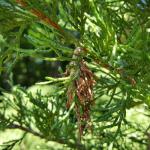 In recent years, the common bagworm has become ever more noticeable in Massachusetts, particularly in urban forests and managed landscapes (despite the fact that we are historically on the northern edge of this native insect’s range). Anecdotally, populations seems to be rising in certain areas of MA and were particularly noticeable to professionals and the general public in 2020. Bagworm overwinters in the egg stage within the protective bag-like coverings of deceased females from last season. Bagworm egg hatch is expected by mid-June, or roughly between 600-900 GDD’s. Now is the time to keep your eyes open for these caterpillars who feed on the foliage of arborvitae, juniper, cedar, pine, sycamore, maple, locust, boxelder, linden, and over 120 species of trees and shrubs (catch them now before they grow large and have done most of their feeding by August). More information can be found at: https://ag.umass.edu/landscape/fact-sheets/bagworm
In recent years, the common bagworm has become ever more noticeable in Massachusetts, particularly in urban forests and managed landscapes (despite the fact that we are historically on the northern edge of this native insect’s range). Anecdotally, populations seems to be rising in certain areas of MA and were particularly noticeable to professionals and the general public in 2020. Bagworm overwinters in the egg stage within the protective bag-like coverings of deceased females from last season. Bagworm egg hatch is expected by mid-June, or roughly between 600-900 GDD’s. Now is the time to keep your eyes open for these caterpillars who feed on the foliage of arborvitae, juniper, cedar, pine, sycamore, maple, locust, boxelder, linden, and over 120 species of trees and shrubs (catch them now before they grow large and have done most of their feeding by August). More information can be found at: https://ag.umass.edu/landscape/fact-sheets/bagworm
Tawny Simisky, Extension Entomologist, UMass Extension Landscape, Nursery, & Urban Forestry Program
Garden Clippings Tips of the Month
June is the time to . . . .
After spring’s mad scramble in April and May to tidy up edges, dig and divide perennials, fertilize lawns, move and or plant shrubs and trees, and plant up annuals and containers, June seems like it should be a breeze. But don’t kick back in your hammock just yet; there are critical tasks to be done in June that can lay the foundation for success (or not) in the rest of the season. Here are a few things to consider:
- Prune spring blooming trees and shrubs, including rhododendrons and azaleas (Rhododendron sp.) ; andromeda (Pieris sp.); mock orange (Philadelphus sp.); bridal wreath Spiraea (Spiraea prunifolia); flowering quince (Chaenomeles sp.); kerria (Kerria japonica), and viburnums (V. carlesii, V. carlcephalum, V. plictum var. tomentosum); dogwood (Cornus florida); redbud (Cercis canadensis); cherries (Prunus sp.) and apples and crabapples (Malus sp.) within a couple of weeks of flowering. These plants will bloom on wood that is formed this growing season (as well as older wood in some cases), so pruning right after flowering gives give plants plenty of time to develop wood and flower buds for next year. Most summer blooming trees and shrubs like butterfly bush (Buddleia sp.); bluemist shrub (Caryopteris divaricata), panicle hydrangea (Hydrangea paniculata), rose of Sharon (Hibiscus syriacus) and beautyberry (Callicarpa sp.) bloom on new wood, so can be pruned in late winter or early spring and can be expected to provide bloom later in the season.
- Allow bulb foliage to mature completely before cutting back. Though the foliage of tulips, daffodils, autumn crocus and other spring bulbs can be a bit unsightly, it is all part of the normal cycle of a garden. If you want these plants to thrive, you must allow 6-8 weeks for the foliage to fully mature, sending nourishment to the underground portion and providing for flowers for next spring. The foliage on many early bulbs like Scilla luciliae or Scilla siberica comes early and vanishes by mid- June. The foliage of narcissus can linger into July. Cutting the foliage too early, braiding or otherwise constricting the foliage and perhaps breaking leaved can result in a lack of flowers in the following season. Tulips give no guarantee of flowering in subsequent years, though many often do. They are frequently treated as annuals, pulled out and disposed of in spring. Species tulips, T. kaufamanniana cultivars, Darwin hybrids and many lily-flowering tulips stand a better chance of returning year after year given the right growing conditions and allowed to fully mature in spring. Deadhead spent blossoms so that maximum energy is returned to the bulb for next year's growth rather than being spent on making seeds.
- Mulch annual and perennial beds with organic mulch like shredded leaves, well-rotted compost, or compost/fine bark mixes. Mulch will help to conserve moisture, moderate soil temperature fluctuations, reduce weeds, and add organic material back to the soil as it breaks down.
- Grass clippings from organic lawns make a nice mulch in vegetable plot. Be sure to only use clippings from pesticide-free lawns, and only when there are no weeds or grasses going to seed. Mulch lightly (½” - 1” layer) and repeat if necessary as the grass begins to break down over the season. Gather the clippings in a bagger and spread immediately. Grass clippings left in a pile or held for more than several hours will heat up and begin to break down quickly, resulting in an unusable slimy mess.
- Start scouting for damaging insects like rose slugs, hibiscus sawfly, three-lined potato beetles, cabbage loopers, columbine sawflies, viburnum leaf beetle, imported willow leaf beetle, and lily leaf beetle and their larvae. Many of these insects can be controlled by hand if caught early, so frequent scouting is important.
- We closed out the month of May with a hot dry spell. Pay close attention to watering new transplants and containers. Most annual displays, vegetable gardens and lawns need 1” of water each week. If nature doesn’t cooperate, supplemental watering might be necessary during dry spells. Many communities prohibit or limit watering, so careful selection of plants which tolerate onsite conditions and reducing water-gobbling turf is a wise move. Remember, newly transplanted trees and shrubs, even those planted last year, will need a long drink of water weekly during dry spells.
- Stake lilies, dahlias, tomatoes and delphiniums early in the month using stakes, cages or trellises that will support the full height of the plan in August. Tie stems every 12-18” as the plants grow or create a web of crisscrossing strings at similar spacing to support a mass of stems. Pinch and remove side shoots and suckers to direct energy to buds as desired.
- Continue to pinch asters and chrysanthemums into early July to reduce height, encourage bushier plants, and encourage more flowers.
- Many people choose to dead-head rhododendrons, mountain laurel and lilacs when flowering is finished for a tidier appearance and to focus energy on plant growth rather than seed production. This optional task should be completed as flowering finishes.
Hopefully when the heat kicks in and summer officially arrives you’ll have some time to kick back in your hammock to enjoy a few moments of relaxation!
Joann Vieira, Director of Horticulture, Trustees
The Worcester Tree Initiative: A Community NGO at the Center of Reclaiming an Urban Forest
A Community in Need
In August 2008, the nonnative, invasive Asian longhorned beetle (Anoplophora glabripennis) (ALB) was discovered in the City of Worcester, Massachusetts. This wood-boring insect is known to infest a wide range of host trees, including maple, birch, elm, and willow. Its very presence constituted a serious risk to the eco-tourism (i.e., fall leaf color) and forest industries of New England. It also threatened the maple syrup industry in a region where Vermont produces over 40% of the United States’ supply of maple syrup – a value of $131 million annually (Moulton 2016). With an estimated 30.4% of urban trees (1.2 billion trees) at risk from ALB nationwide, yet another find meant that the benefits of the urban forest in other regions of the country were at risk unless drastic action was taken to stop the spread of this lethal insect. Mortality in this order would result in a loss of 34.9% of total canopy cover nationwide, valued at $669 billion USD (Nowak 2001).
Located approximately 40 miles west of Boston and 40 miles north of Providence, Rhode Island, Worcester is known as the "Heart of the Commonwealth" of Massachusetts.
The presence of ALB in not only the geographic center of Massachusetts, but also a location central to the entire region, could be potentially devastating to susceptible trees throughout New England. To restrict the movement of infested wood and contain the ALB population, the Massachusetts Department of Conservation & Recreation (DCR) initially instituted a quarantine covering 33 square miles that included part of the City of Worcester and surrounding communities of Holden, Boylston, West Boylston, and Shrewsbury. In September 2008, the federal Department of Agriculture’s Animal Plant Health Inspection Service (USDA APHIS) followed with a federal quarantine mirroring the state one. As more infestations were found in the area in 2008, the regulated area was expanded.
The only effective means to eradicate ALB is to remove and chip infested trees, as well as other potentially-susceptible trees. Due to the widespread infestation, specialists began to remove what would eventually total more than 30,000 trees from streets, private landscapes, and public parks in the regulated area. Loss of urban forest of this magnitude would be as devastating to the citizens of these neighborhoods as it would be to the urban ecosystem. In response to the burgeoning outcry, U.S. Congressman James P. McGovern and Tim Murray, then Lieutenant Governor, established the non-profit Worcester Tree Initiative (WTI) in January 2009. WTI’s original mission was to educate citizens about ALB, about proper tree planting, and to provide free trees to residents. Funding for WTI was generated through donations from individual citizens and businesses, as well as state and federal grants.
In the spring of 2009, WTI got to work with the City of Worcester by establishing an initial goal of planting 30,000 trees in five years. WTI began by engaging virtually any willing party(ies) within the ALB quarantined zone. This included community groups, school groups, private citizens, municipal employees, and other municipalities desiring to learn about ALB life history and identification, and about the planting and care of urban trees. Citizens who participated in these training sessions were then eligible to receive free trees themselves. Over the ensuing years, WTI held these training and tree giveaway events several times every spring and fall.
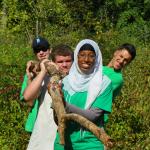
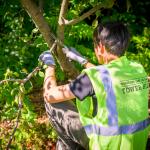 In 2011, WTI identified the need for ongoing, post-planting tree care for city trees, and kicked-off their Young Adult Foresters (YAF) program. They employed at-risk youth that were identified through the Worcester Youth Center, and Girls Inc. Both organizations help prepare local youth by giving them job readiness skills. With a rented truck and water tank that had been borrowed from the City of Worcester’s forestry division, WTI staff worked alongside youth, properly training them in delivering essential water to Worcester’s newly planted trees. This not only provided a much-needed service to the city, but was also the first paying job for many of the program’s young participants. They learned new skills, were educated about careers in the green industry, and learned about the importance of community engagement. In autumn 2014, the City of Worcester celebrated the planting of its thirty thousandth tree – of which over 6,250 trees were planted directly by WTI!
In 2011, WTI identified the need for ongoing, post-planting tree care for city trees, and kicked-off their Young Adult Foresters (YAF) program. They employed at-risk youth that were identified through the Worcester Youth Center, and Girls Inc. Both organizations help prepare local youth by giving them job readiness skills. With a rented truck and water tank that had been borrowed from the City of Worcester’s forestry division, WTI staff worked alongside youth, properly training them in delivering essential water to Worcester’s newly planted trees. This not only provided a much-needed service to the city, but was also the first paying job for many of the program’s young participants. They learned new skills, were educated about careers in the green industry, and learned about the importance of community engagement. In autumn 2014, the City of Worcester celebrated the planting of its thirty thousandth tree – of which over 6,250 trees were planted directly by WTI!
Collaborations & Partnerships
In 2016, WTI formally became a program of Tower Hill Botanic Garden (THBG). This merger created a stable funding-stream for WTI, enabling them to focus more on their mission. It also enhanced THBG’s capacity to serve the citizens of Worcester as originally envisioned in 1842 by the founders of the Worcester County Horticultural Society, the organization that started THBG in 1986 and operates it today. In 2017, WTI commenced their ‘Master Tree Stewards Training Program’ – an initiative designed to educate and train interested citizen scientists about the care of urban trees. This program consisted of four weeks of classes about tree identification and biology, pests, pruning, and planting. In return for the training opportunity, graduate Master Tree Stewards would complete volunteer hours on urban tree-related projects. They would also act as “neighborhood tree stewards,” disseminating information about urban tree care within their local community networks, and advocating for the well-being of public trees and urban forests in central Massachusetts.
Municipal tree care in Massachusetts requires the approval of the city’s urban forester (known as a Tree Warden). Hence, the City of Worcester has been an important collaborator of WTI since its inception. The forestry division has donated the use of its equipment and materials, including providing water for urban tree watering programs. They have also co-authored numerous grants with WTI. The state’s Department of Conservation & Recreation (DCR) has had a shared mission in the fight against ALB, and has worked alongside WTI to regularly collaborate on urban tree planting and maintenance projects, and public outreach. USDA APHIS has donated office space to WTI and facilitated communication with other organizations.
Over the years, WTI began looking for space to establish an urban tree nursery and conduct educational programming. The Greater Worcester Land Trust had been given land in a lower-income neighborhood in Worcester. Desiring that the land remain in a productive and maintained state, a collaboration between the Land Trust and WTI ensued. They mutually agreed that the site would be used as a nursery and an educational site, benefitting all parties involved and the community at large.
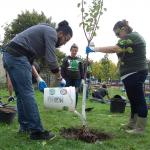 The Main South Community Development Corporation (CDC) is a Worcester-based organization that was founded in response to Main South neighborhood residents’ concerns regarding community decline and lack of affordable housing. Main South CDC provides outreach to local citizens in need – many of whom are first-generation immigrants who are struggling to adapt to their new home and learn a new language. WTI and Main South CDC have collaborated to improve the urban forest in Main South while educating the residents through tree plantings, tree giveaways, and tree-related programming.
The Main South Community Development Corporation (CDC) is a Worcester-based organization that was founded in response to Main South neighborhood residents’ concerns regarding community decline and lack of affordable housing. Main South CDC provides outreach to local citizens in need – many of whom are first-generation immigrants who are struggling to adapt to their new home and learn a new language. WTI and Main South CDC have collaborated to improve the urban forest in Main South while educating the residents through tree plantings, tree giveaways, and tree-related programming.
The City of Worcester, has traditionally had a strong legacy of post-secondary education. Over the years, WTI has employed numerous student interns from colleges and universities like College of the Holy Cross, Worcester Polytechnic Institute, Clark University, and Worcester State University. Many of these interns have spent countless hours collecting data from newly-planted trees, co-writing grants, and lending expertise. The state land-grant institution, University of Massachusetts, Amherst, has been a strong ally of WTI, providing technical expertise and fostering connections between WTI and other organizations. UMass Extension has also sponsored a ‘summer scholar’ intern position to provide technical and programming support to WTI.
In recent years, WTI teamed up with the Green Hill Park in Worcester to help re-establish a living World War I memorial known as Memorial Grove. Originally consisting of 380 maple trees – one for each member of the service from Worcester who gave their life during World War I – this collaboration is working to return this space to its original splendor. These efforts began in 2016 with the installation and care of 40 trees.
WTI Today
 In spring 2020, WTI celebrated its 11th year in operation. Though WTI started in response to a community crisis with the initial charge of re-planting trees throughout the City of Worcester, their mission has evolved to serve the community in other ways. Having THBG as its parent organization, WTI is now actively expanding the community outreach arm of the botanical garden. Celebrating its 9th year, their YAF program continues with the watering and maintenance of newly planted city trees. In 2020 their ‘Master Tree Stewards Training Program’ marked its third year of citizen engagement and education. Graduates of the program are continuing to volunteer to care for young trees in Worcester. Care and maintenance of Memorial Grove continues in partnership with the City of Worcester. WTI is also excited about spending its first year in the urban nursery. In addition to growing trees for the citizens of Worcester, the nursery is also being used to explore various production techniques, including growing trees using the Missouri gravel bed system.
In spring 2020, WTI celebrated its 11th year in operation. Though WTI started in response to a community crisis with the initial charge of re-planting trees throughout the City of Worcester, their mission has evolved to serve the community in other ways. Having THBG as its parent organization, WTI is now actively expanding the community outreach arm of the botanical garden. Celebrating its 9th year, their YAF program continues with the watering and maintenance of newly planted city trees. In 2020 their ‘Master Tree Stewards Training Program’ marked its third year of citizen engagement and education. Graduates of the program are continuing to volunteer to care for young trees in Worcester. Care and maintenance of Memorial Grove continues in partnership with the City of Worcester. WTI is also excited about spending its first year in the urban nursery. In addition to growing trees for the citizens of Worcester, the nursery is also being used to explore various production techniques, including growing trees using the Missouri gravel bed system.
Since its establishment in 2009, WTI has received local, regional, national, and international attention for its efforts and success. In 2016, WTI was presented with an award from the Vermont Maple Sugar Makers Association as a result of its efforts to help contain ALB, and the following year WTI received ISA’s Gold Leaf Award. From working with students and education specialists in local schools, to private citizens, to municipal and private-sector professionals, WTI has demonstrated how a local NGO can capitalize on community will, for the good of the environment and its citizens. WTI may have been formed to provide education and give away trees, but it has also helped to deliver a sense of hope and optimism to a community and its urban forest. Serving as a model for other NGOs, WTI will continue to be highly responsive to community needs, and to serve the urban forest of Worcester in new and innovative ways for years to come.
To learn more about the Worcester Tree Initiative, visit https://www.towerhillbg.org/worcester-tree-initiative.
To learn more about the Asian Longhorned Beetle and current activities in Massachusetts, go to https://www.aphis.usda.gov/aphis
References
Moulton, C (2016). Sugar makers, foresters say thanks for battling Asian longhorned beetle. Telegram & Gazette. Retrieved from https://www.telegram.com/news/20161213/sugar-makers-foresters-say-thanks-for-battling-asian-longhorned-beetle
Nowak, D.J. Pasek, J.E., et al. (2001). The Potential Effect of Asian Longhorned Beetle (Anoplophora glabripennis) on Urban Trees in the United States*. An abstract prepared for the USDA Interagency Research Forum on Gypsy Moth and Other Invasive Species, (January 16-19, 2001 Annapolis, Maryland). http://www.uvm.edu/~albeetle/research/impact.html
Alexander J. Elton, Benjamin S. Weil, & Richard W. Harper, Dept. of Environmental Conservation, University of Massachusetts Amherst
Upcoming Events
For more details and registration options for any of these events, go to the UMass Extension Landscape, Nursery, and Urban Forestry Program Upcoming Events Page.
-
June 8 - Tick & Mosquito Education Day - Tick Topics
Credits: 2 pesticide contact hours for categories 29, 35, 36, 37, 48 and Applicators (core) license. Association credits: 1 education & 2 safety MCLP credits; 1 education & 2 safety MCA credits; 1 MCH credit; 2 ISA; and 2 (cat 2) SAF credits available. -
June 15 - Tick & Mosquito Education Day - Mosquito Topics
Credits: 2 pesticide contact hours for categories 29, 35, 36, 37, 46, 47, 48 and Applicators (core) license. Association credits: 1 education & 2 safety MCLP credits; 1 education & 2 safety MCA credits; 1 MCH credit; 2 ISA; and 2 (cat 2) SAF credits available. -
June 30 - Urban Forestry Today’s 2021 Summer Tree Summit
Credits: 1 MCA and 2 ISA credits available (no pesticide credits available for this webcast).
Pesticide Exam Preparation and Recertification Courses
These workshops are currently being offered online. Contact Natalia Clifton at nclifton@umass.edu or go to https://www.umass.edu/pested for more info.
InsectXaminer!
Episodes so far featuring gypsy moth, lily leaf beetle, euonymus caterpillar, and imported willow leaf beetle can be found at: https://ag.umass.edu/landscape/education-events/insectxaminer
TickTalk with TickReport Webinars
To view recordings of past webinars in this series, go to: https://ag.umass.edu/landscape/education-events/ticktalk-with-tickreport-webinars
Additional Resources
For detailed reports on growing conditions and pest activity – Check out the Landscape Message
For professional turf managers - Check out our Turf Management Updates
For commercial growers of greenhouse crops and flowers - Check out the New England Greenhouse Update website
For home gardeners and garden retailers - Check out our home lawn and garden resources.
Diagnostic Services
Landscape and Turf Problem Diagnostics - The UMass Plant Diagnostic Lab is accepting plant disease, insect pest and invasive plant/weed samples . By mail is preferred, but clients who would like to hand-deliver samples may do so by leaving them in the bin marked "Diagnostic Lab Samples" near the back door of French Hall (please note that visitors are not allowed inside the building). The lab serves commercial landscape contractors, turf managers, arborists, nurseries and other green industry professionals. It provides woody plant and turf disease analysis, woody plant and turf insect identification, turfgrass identification, weed identification, and offers a report of pest management strategies that are research based, economically sound and environmentally appropriate for the situation. Accurate diagnosis for a turf or landscape problem can often eliminate or reduce the need for pesticide use. See our website for instructions on sample submission and for a sample submission form at https://ag.umass.edu/services/plant-diagnostics-laboratory. Mail delivery services and staffing have been altered due to the pandemic, so please allow for some additional time for samples to arrive at the lab and undergo the diagnostic process.
Soil and Plant Nutrient Testing - The UMass Soil and Plant Nutrient Testing Lab is accepting orders for routine soil analysis and particle size analysis ONLY (please do not send orders for other types of analyses at this time). Send orders via USPS, UPS, FedEx or other private carrier (hand delivered orders cannot be accepted at this time). Processing time may be longer than usual since the lab is operating with reduced staff and staggered shifts. The lab provides test results and recommendations that lead to the wise and economical use of soils and soil amendments. For updates and order forms, visit the UMass Soil and Plant Nutrient Testing Laboratory web site.
Tick Testing - The UMass Center for Agriculture, Food, and the Environment provides a list of potential tick identification and testing options at: https://ag.umass.edu/resources/tick-testing-resources.
